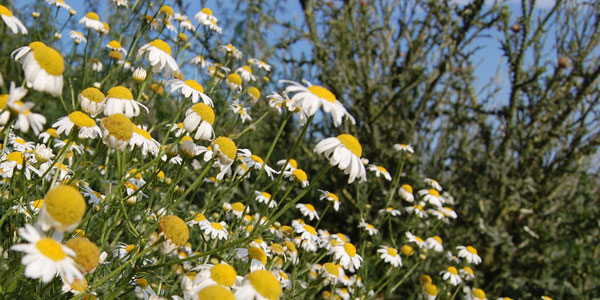
There are many reasons you will want to include chamomile in your herb garden. This popular herb not only makes a soothing tea, but its daisy-like flowers and sweet scent make it a must have for your flower garden. Though it started out in Europe, this fragrant beauty has quickly spread world-wide and is easy to add to your collection as well.
Table of Contents:
Before You Plant
Choose the Right Type of Chamomile:
- There are two main types of chamomile, each with its own distinct properties.
- German chamomile is an annual herb that reaches heights of 2-3 feet.
- Roman chamomile is a perennial herb that only reaches a height of 4-12 inches, making it a good candidate for ground cover.
Find a Suitable Place:
- Chamomile plants need an area that receives full sun.
- If space is limited, consider growing this herb in a container either indoors or on a patio.
- Both herb gardens and flower gardens make great homes for the chamomile plant.
Prepare the soil:
- Proper drainage is important, but soil needs to hold moisture for the plant to grow.
- Soil should be average to rich in quality. Amend poor soil by working in rotted compost or organic matter.
- The acidity of the soil is another factor to consider. Chamomile will grow in a wide range of acidic soil anything with 5.6 – 7.5 pH. There are soil testing kits available at most gardening or home supply stores, or you can have your soil tested by a professional to find out if any adjustments are necessary.
Planting Chamomile
What You Will Need:
- Chamomile seeds
- Prepared soil
- Fertilizer
- Mulch
Steps for Planting Chamomile:
- Properly prepare the soil before planting.
- Seeds need light to germinate, so rather than sowing the seeds, broadcast them onto moist soil in the spring after the last frost.
- Allow one to two weeks for the plants to germinate.
- When seedlings have developed, thin the plants to 6 inches for ground cover or 18 inches for decorative plants.
- Apply fertilizer regularly to achieve maximum plant growth.
- Water regularly to keep the soil moist. Placing mulch around the plants will help to retain moisture.
Growing/Harvesting Chamomile
What You Will Need:
- Garden clippers or scissors
- Tray
- Wire rack
Steps for Care and Maintenance:
- Remove all dead flowers, otherwise known as deadheading, regularly to keep new blossoms forming.
- Harvest flowers by cutting them off as they reach their peak bloom; use fresh in tea or dry for winter use.
- To dry, place flowers on a tray and allow to dry thoroughly in a cool, dark place. Store in an air-tight container.
- In the fall, cut the plant down and cover with mulch to provide protection from harsh winter weather.
- Once planted, this plant will self-seed to produce new plants each year.
Additional Tips and Advice
- Since the flowers of the chamomile plant are eaten, avoid using any pesticides or sprays. If pests become a problem, try an organic treatment. Be sure to check the label carefully.
- Flowers can be used to make fresh tea or combined with other teas to make a delicious herbal blend. It also makes a great addition to punch as it can be served hot or cold.
- Use chamomile to make a hair rinse.
- Chamomile is often used to treat aches and the tea is often used to help with upset stomachs.
- Toothaches can also be treated by grinding the chamomile and mixing with a little water to form a paste. Apply to the irritated tooth for relief.
Make sure your garden doesn’t flood with water.